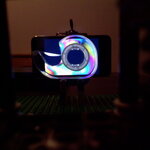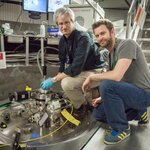Applied Physics

Refining oil starts with distillation
Have you ever wondered why you can't just use raw crude oil
in a diesel engine or why your car won't run by filling the tank with kerosene
or engine oil? If these things could be
done, then in large part, we would not need oil refineries. Rather we could just filter the dirt out of
the raw crude oil and burn that for our various energy needs. Largely, the problem is that crude oil is a
mixture of very many different kinds of hydrocarbons. A hydrocarbon is a molecule made of only carbon
atoms and hydrogen atoms. Typically, a…

I decided to build a polariscope for my Lego optics lab.
On occasion you might need a mechanism to rotate filters such as a polarized filter and a polariscope is a simple and fun way to view the rainbow colors in clear plastic objects such as flatware, tape dispensers, etc.
You can actually make your own polariscope by wearing a pair of 3D cinema spectacles or ordinary polarized sunglasses and sitting in front of an LCD monitor for your computer. Open MS paint (or other drawing program such as gimp). If your default image (the white background) is too small simply drag the lower right…
I’ll demonstrate how I built a worm drive pan/tilt mount out of Lego for your various Lego optics lab lens and filter holders. Some folks might find that the worm drive allows a bit more fine tuning for the rotation and tilt of the lens or mirror mounted on the worm drive pan/tilt mount than they were able to do using the simple pan/tilt mount.
Follow me on Twitter: @SteveSchuler20.
Parts needed
1 Lego Technic turntable gear
1 Lego Technic gearbox for worm gear
1 Worm gear
1 Lego Technic gear 24 tooth
1 Pulley
1 Small pulley
1 Cross axle 10
1 Cross axle 6
1 Three quarter pin
1 Lego…
I’ll demonstrate how I built a worm drive panoramic mount out of Lego for your various Lego optics lab lens and filter holders. Some folks might find that the worm drive allows a bit more fine tuning for the rotation of the lens or mirror mounted on the worm drive panoramic mount than they were able to do using the simple panoramic mount.
Follow me on Twitter: @SteveSchuler20.
Parts needed
1 Lego Technic turntable gear1 Pulley
1 Cross axle 10
1 Worm gear
1 Three quarter pin
1 Plate 2 X 8
2 Plates 1 X 2
2 Lego Technic beams 1 X 2
2 Lego Beams 1 X 8
4 Lego Technic bushings
Here’s how…

Titanium and gold are usually not magnetic and cannot be magnets – unless you combine them just so. Scientists at Rice University did so and discovered what is a first of its kind: an itinerant antiferromagnetic metal -- TiAu -- made from nonmagnetic constituent elements.
The research by the lab of Rice physicist Emilia Morosan has already been cited as a textbook example of how magnetism arises in metals. While the uses for this particular magnet have yet to be determined, the Rice discovery could enhance the scientific understanding of magnetism. This is not the kind of magnet one would…

By Charles Choi, Inside Science -- If you poured a glass of water on a table, you would expect to get a puddle that spreads for a while and then stops. However, until now, the formulas that scientists used to describe the flow of fluids suggested the puddle should never stop spreading.
Now researchers have solved the mystery of why such a puddle would not keep spreading endlessly — the culprit is a force that acts on microscopic scales. This solution to such a simple everyday phenomenon could have far-reaching ramifications for everything from improving advanced electronics to fighting…
I’ll demonstrate how I built upon my Lego simple panoramic mount to create a simple pan/tilt mount for your various Lego optics lab lenses and filter holders.
Follow me on Twitter: @SteveSchuler20.
Parts needed
1 Lego Turntable 4 X 4
2 Lego Beams 1 X 4
2 Lego Hinges 2 X 4
Here’s how I built my Lego simple pan/tilt mount.

A humble soil additive used by millions of amateur and professional gardeners alike is set to slash the cost of the most effective form of insulation for buildings.
Brunel University London academic Dr. Harjit Singh has proved in the laboratory that vacuum insulation panels can be made with a core of perlite - the volcanic ore “popcorn” used in horticulture to improve drainage and water retention.
This dramatically reduces the cost of the panels which are normally made by surrounding a core of fumed silica with metallised PET envelope. Initial cost savings are estimated to be at least 30 per…

New research has confirmed plutonium's magnetism, which scientists have long theorized but have never been able to experimentally observe.
Plutonium was first produced in 1940 and its unstable nucleus allows it to undergo fission, making it useful for nuclear fuels as well as for nuclear weapons. Much less known, however, is that the electronic cloud surrounding the plutonium nucleus is equally unstable and makes plutonium the most electronically complex element in the periodic table, with intriguingly intricate properties for a simple elemental metal.
While conventional theories have…

Metals, which conduct electricity, and insulators, which don’t, are polar opposites.
At least that’s what we’ve believed until now.
But we have discovered that a well-known insulator can simultaneously act like a conductor in certain measurements. We don’t yet know the reason for this mysterious behaviour but it is likely due to new and exciting quantum effects.
The finding is surprising because electrons in insulators, such as glass, are largely stuck in one place, yielding high resistance to the flow of electricity. On the other hand, electrons in conducting materials such as metals flow…